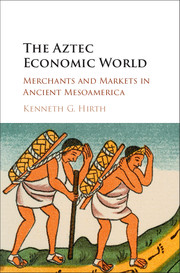Book contents
- Frontmatter
- Contents
- List of figures
- List of tables
- Preface
- Abbreviations
- 1 Introduction to the Aztec economic world
- 2 The structure of Mesoamerican economy
- 3 The Mesoamerican marketplace
- 4 Merchants, profit, and the precolumbian world
- 5 Often invisible: domestic entrepreneurs in Mesoamerican commerce
- 6 The professional retail merchants
- 7 Merchant communities and pochteca vanguard merchants
- 8 The tools of the trade and the mechanics of commerce
- 9 Conclusions
- Notes
- Glossary of Nahuatl and early colonial Spanish terms
- Bibliography
- Index
9 - Conclusions
Published online by Cambridge University Press: 05 May 2016
- Frontmatter
- Contents
- List of figures
- List of tables
- Preface
- Abbreviations
- 1 Introduction to the Aztec economic world
- 2 The structure of Mesoamerican economy
- 3 The Mesoamerican marketplace
- 4 Merchants, profit, and the precolumbian world
- 5 Often invisible: domestic entrepreneurs in Mesoamerican commerce
- 6 The professional retail merchants
- 7 Merchant communities and pochteca vanguard merchants
- 8 The tools of the trade and the mechanics of commerce
- 9 Conclusions
- Notes
- Glossary of Nahuatl and early colonial Spanish terms
- Bibliography
- Index
Summary
More than a century ago Emile Durkheim observed that societies with higher levels of economic interdependence were more tightly integrated socially than those that were not. Durkheim referred to this economic interdependence as organic solidarity and felt that the social structures that emerged from the division of labor produced and supported larger and more durable societies. Commerce and exchange is the manifestation of economic interdependence and is a good point of departure for examining the scope of economic interaction in ancient and premodern societies around the world. It serves as a means of assessing not only internal integration as Durkheim suggested, but also the level of interaction between societies and across political boundaries.
The fundamental objective of this volume has been to explore the scale, complexity, and integration of the Aztec economic world so that it could be incorporated into a broader comparative discussion of ancient economy. What can be observed at the moment of the Spanish conquest was the end product of several thousand years of economic interaction between people located in ecologically diverse environmental zones in close proximity to one another. The organic development of marketplaces within different resource zones helped to stimulate commerce even under conditions where all goods moved on the backs of human porters. This system of regional commercial symbiosis was the foundation of the highland Nahua economy.
What the Aztecs added to this economic landscape was military conquest that extracted a huge quantity of wealth from a tribute empire covering between 160,000 and 165,000 sq km across Mesoamerica. This wealth was funneled into the Basin of Mexico and the three primary cities of the Aztec military alliance: Tenochtitlan, Texcoco, and Tlacopan. It stimulated a wave of economic development as it trickled down into society through state sponsored festivals, elevated elite consumption, and rewards to warrior knights and military personnel. The tribute extracted from the Aztec empire also had a twofold effect on the conquered provinces. It forced an increase in regional production to meet Aztec tribute demands and stimulated inter-regional commerce within the empire to obtain the goods that provinces could not produce. The combination of these economic and political forces created the economic affluence and level of commercial activity that the Spanish encountered in AD 1519.
- Type
- Chapter
- Information
- The Aztec Economic WorldMerchants and Markets in Ancient Mesoamerica, pp. 270 - 294Publisher: Cambridge University PressPrint publication year: 2016



